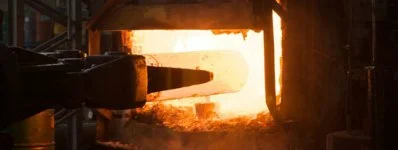Die Heat Treatment
At GAL, we have the capability to undertake these heat treatment processes through our associate vendors. All of GAL’s state - of – the - art extrusion dies are compatible for nitrogen surrounding, resulting in much better quality of extrusions supplied. We ensure that the processes are carried out as per the highest standards of quality and as per the specifications of our customers.
The treatment consists of fully automatic fluidized bed die heat treatment and nitriding system with inert gas. This ensures totally oxide free hot working of die steel with zero deformation and accuracy of extrusion tooling


Heat treatment & nitrogen surrounding atmosphere
While during extrusion it is essential to create oxygen free atmosphere at least for initial 300mm of Extrusion as well as to prevent the die bearing from overheating. GAL’s all state of art extrusion dies are compatible for Nitrogen surrounding resulting much better quality of extrusions supplied.
During extrusion it is essential to create oxygen free atmosphere at least for initial 300mm of extrusion as well as to prevent the die bearing from overheating.
Properties of nitrogen used in extrusion process are:
✔
Inertness: nitrogen is inert to aluminium
✔
Coolant:
Liquid nitrogen at -320°F, has excellent cooling properties. First, the hot section of the profile is surrounded by protective nitrogen gas. Also, the die and the extruded product are cooled by the nitrogen.
How nitrogen improves surface quality
The nitrogen is applied either in liquid or gaseous form, to form an inert atmosphere surrounding the section as it emerges from the die.
This decreases the formation of aluminium oxide, as the oxidation is most severe at this point where the profile is at its hottest. Subsequent cooling by liquid nitrogen, further decreases the degree of oxidation.
Increased capacity and prolonged die life with cooling:
During extrusion the temperature of the die is further raised by friction and plastic deformation of the aluminium. By cooling the tool assembly, particularly the die with liquid nitrogen, extrusion rates can be increased without raising the section temperature above the permissible level. The increase in extrusion speed will largely depend on the alloy and profile being extruded.
Nitrogen cooling reduces wear on the die, which means that more profiles can be extruded before the die has to be repaired or replaced.
Commonly used heat treatment process:
✔ Solutionzing
Keep in surface at 525 Degree celsius for 8 Hours
✔ Quenching
Sudden quenching in water at 30 Degree Celcius
✔Natural Aging
Upto 5 Hrs
✔ Precitipation
Keep in funance at 165 Deg Cel. 8 Hours.
Metallurgy of heat treatment of aluminiumalloys
Aluminium and its alloys are used in a variety of cast a(and) wrought forms and conditions of heat treatment. Forging, extrusions, sections, etc., are examples of wrought products, while sand, gravity and pressure die castings are generally adopted casting methods.
It has been the practice of designers to specify heat treatment to enhance mechanical properties, hardness and machinability.
Only certain aluminium alloys containing alloying elements like CU, Si, Mg and Zn in certain specific percentages can be heat treated to have desired mechanical properties. Other non-heat treatable alloys can at the most be annealed to facilitate forming operations